About a quarter of the population suffers from such a problem as warts. Someone does not pay any attention to them, but someone worries, tries to treat them. Most neoplasms do not pose a particular threat, but there are deadly (malignant) types.
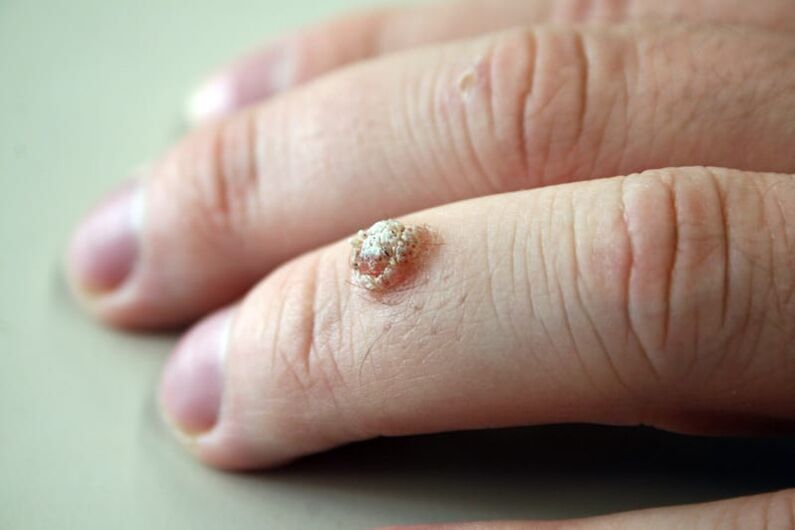
Their appearance is a serious dermatological disease that has arisen as a result of the human papillomavirus entering the body with weak immunity or a serious illness. The virus affects not only the visible parts of the body: hands, face, legs, but also the internal system of the body, remains for life. A person lives unaware of the disease, is a carrier and, unfortunately, infects healthy people.
Today, more than a hundred varieties of this pathogen are known. Only people are susceptible to it, so the fear of getting infected from animals, especially toads, is a myth.
What is a wart?
WartIt is a benign neoplasm on the skin caused by a virus. It develops in the form of a nodule or papilla. They can be one at a time or in close-knit groups. Spread among children and adults with weak immunity.
In children, there is a desire to tear off or simply scratch the wart, this leads to the transmission of the infection to a clean area of \u200b\u200bthe skin. Warts behave completely unexpectedly: they can disappear on their own without any effect on them, or they may not be affected by the most effective drugs and treatments.
Types of warts
flat
Oval plaquesup to 9 mm in size, slightly rise above the skin. Painted in gray-yellow or yellow-pink colors. They form numerous clusters. Cause itching. Outwardly, they resemble a nettle burn. Appear on the face, neck, back side of the skin of the arms and legs, the body of girls, boys. This species is not found in adults. Occur during hormonal changes in the body.
Hence the second namejuvenile warts. Their appearance on the skin of the face of young men can provoke the start of using razors: wounds on the skin of the face, neck and non-compliance with basic hygiene rules. Pass on their own.
A photo
A photograph of flat warts clearly demonstrates the characteristic features of this type:
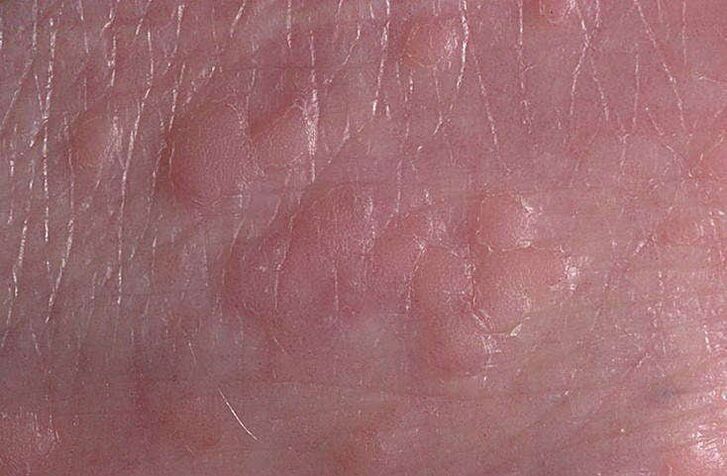
Vulgar
The most common type. It especially affects children. Location - fingers, palms, hands, rarely appear on the mucous membranes. Outgrowth from 0. 5 to 2 mm, flesh-colored, may be with red patches.
Grow from maternal warts to children. This type of treatment is not required. After 3-6-8 months they disappear on their own. A few cases have been identified when the wart lasted 1. 5 years. Of course, they can be removed if they are localized on a large area of the skin or cause discomfort when moving.
A photo
The photograph shows the structure and location of the vulgar wart on the fingers:
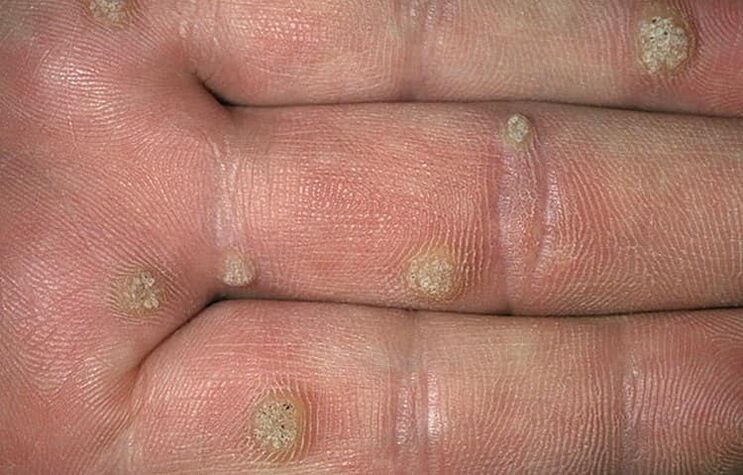
filiform
A common sight among the elderly. In rare cases, pregnant women are affected, signaling a problem in the course of pregnancy, also with menopause in women, as the hormonal background goes astray. At the initial stage, a bump is formed, increasing in size, taking the form of a flesh-colored thread from 5 to 10 mm. They can merge in groups, forming a scallop.
They appear in the area of the eyes, nose, neck, groin, armpits, around the chest in women, that is, where there is delicate skin, there are folds and places with excessive sweating. Requires careful observation of specialists, treatment. They don't go by themselves. It needs to be treated or removed.
A photo
The photo shows filiform warts that struck the eye:
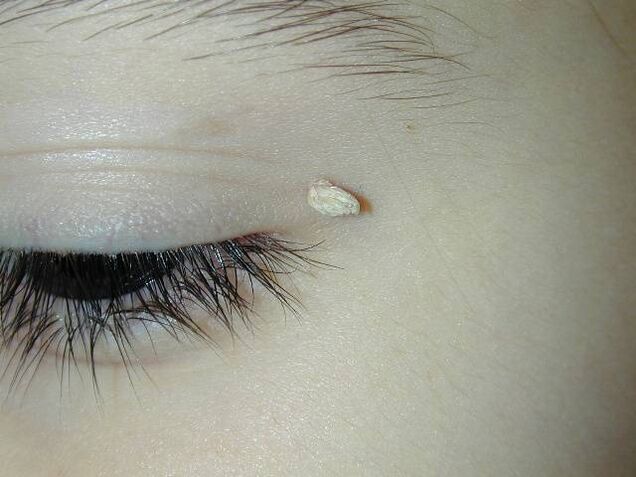
Genital warts
small formationsflesh pink, divided into slices. Outwardly, they resemble a cauliflower inflorescence. Develop on the genitals, anus, in rare cases in the oral cavity, urethra. In appearance, warts are confused with mother-of-pearl papules, which are not a disease.
Genital warts are soft to the touch, attached to a thin stem, can be of different sizes: from 2 millimeters to 10 centimeters. They are transmitted only sexually, therefore they belong to the venereal disease of the same name. Areas with small cracks or injuries are especially vulnerable.
They appear 2-3 months after sexual contact, if the immunity is excellent, then the process can stretch for decades. The spread of the virus in the body can cause cervical cancer in women and penile cancer in men. Therefore, if this type of wart is found, it is important to urgently contact doctors - specialists: a venereologist, a gynecologist. Get rid of only treatment and removal.
A photo
The photo shows pointed (anogenital) warts:
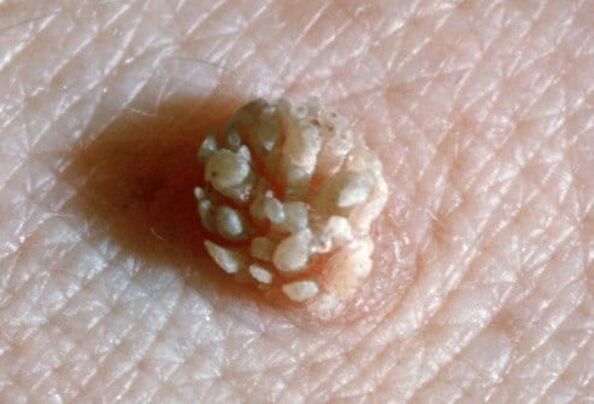
Senile (seborrheic keratosis)
Occur in older people.Dark brown or blackresemble melanomas (malignant tumors), so it is important to consult an oncologist. Appear on the face, neck, torso. This type of neoplasm is the only one not caused by the human papillomavirus. Over time, the wart becomes dense to the touch, covered with a keratinized crust with black or white "pearls".
Location - chest, neck, face, arms. Do not appear on the soles and palms. The size is from 2 mm to 6 cm. Both single outgrowths and foci of accumulations up to several tens are possible. In patients with multiple seborrheic keratosis, a family history is sometimes noted, which is a reflection of hereditary predisposition.
This species develops slowly, over several decades, and does not undergo malignant transformation. They require observation and treatment. Remove as directed by a doctor.
Important: with the appearance of a neoplasm on the skin of an elderly person, you should immediately see a dermatologist and oncologist so as not to miss the development of skin cancer!
A photo
The pictures show the four stages of development of senile warts.
Spot stage:
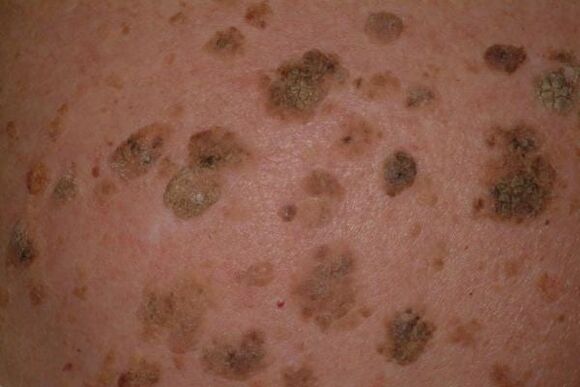
Papular form (nodules and papules):
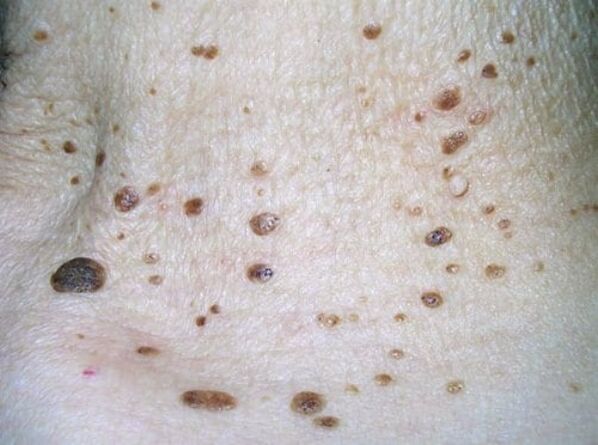
Keratotic:
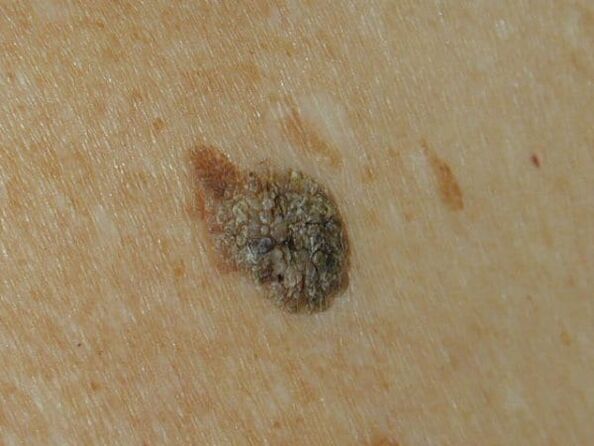
Skin horn:

Typical localizations of warts
Warts most often appear in the following places:
Facial warts:
- Flat - the most common type, affects the cheeks, the area around the mouth.
- Vulgar - can appear on any part of the face as single formations or several in different areas.
- Filiform - favorite places are the eyelids, lips, neck.
Warts on hands and arms:
- Vulgar - affect fingers, palms, hands (photo).
- Flat - the back of the palms, the outer side of the elbow joint area, the nail plates (photo).
Plantar warts.Localization - fingertips, bases of fingers, foot. Plantar warts are popularly called "spike". Appear in places of pressure of shoes, especially in people suffering from constant sweating of the feet. A keratinized outgrowth of a yellowish-gray color. The appearance is observed singly, in rare cases, a group of three to five formations. Cause discomfort when walking. Pass on their own or are removed surgically, cauterization.
Causes of warts
As we already know, the source of the appearance of neoplasms is the insidioushuman papilloma virus.Infection from a carrier of an infection to a healthy person by household, sexual contact, through objects of collective use.
It is easy to pick up a virus in places of rest - a bathhouse, a sauna, a beach, a pool. Favorable for infection at night, in the evening, as the sun's rays are detrimental to the virus. Symptoms of the disease appear after two to five months.
Factors that contribute to the appearance of warts:
- Weak immunity.
- Synthetic shoes.
- Sweating.
- Violation of metabolism in the body.
- Endocrine pathology.
- Stress.
- Fungal and other infectious diseases.
- Insufficient hygiene.
- Lack of nutrients in the body.
- Casual sex.
- Non-compliance with the rules of asepsis and antisepsis during manicure and pedicure.
Treatment of warts at home
When a build-up appears, first of all, you should seek the advice of a dermatologist. He will examine, determine the nature of the occurrence and type of education. He will prescribe the appropriate treatment for your case. In the initial stages, drug treatment is highly effective.
In children
Treatment of warts in children:
- Ointment prescribed by a dermatologist. Treat the wart itself directly, after steaming it out, wait for complete absorption. The effect occurs from two weeks to two months.
- Medical plaster for the treatment of warts. It is saturated with salicylic acid. The advantage of the patch is that the affected area is covered. This does not prevent the child from playing. It also prevents bacteria from entering the wound, thereby blocking the further spread of the virus.
- antiviral therapy.
- Apply drugs to protect the immune system.
- Conduct preventive vitamin courses.
Tips from traditional medicine:
- Fresh juice of celandine, dandelion or garlic. Treat the wart several times a day.
- Dough with vinegar essence. Mix two drops of essence with flour. Cut a small hole in the patch, equal to the size of the wart. Glue the blank, thereby protecting healthy areas of the skin. We put a piece of the resulting dough in the hole, fix it on top with another small piece of plaster. It is better to carry out the procedure at night. The result is possible in the morning.
- Lotions from a decoction of wormwood.
If new neoplasms appear after removal, you should think about the state of the baby's immunity. It is important to carefully consider the nutrition of the child, devote more time to walks in the fresh air. If the body's defenses work at full strength, knowledge of how to remove a wart from a child will not be needed. The body will be able to cope with the virus on its own.
In adults
You can use chemicals from pharmacies: antiviral ointments and creams containing alkali or acid.
In addition, you can use:
- Caustic agent based on phenol and meta-cresol. Using the applicator, treat the wart without getting on healthy skin. Used to remove plantar, filiform, common warts.
- Preparation with sodium hydroxide. It is considered the best remedy. Use strictly as directed by your doctor.
- Remedy with celandine grass juice. The drug is not only for removing warts, it is also an antiviral agent.
- Spray with refrigerant, temperature minus 57 degrees.
- A solution based on a mixture of different acids.
- Antiviral gel containing a unique synthetic peptide. Suitable for adults and children.
- A combination of polysaccharides, acetic and citric acids, potassium iodide, extracts of aromatic plants and celandine. The drug has no side effects.
Wart removal
You need to start by examining the wart by a doctor, this will help to understand the cause of the occurrence and prevent recurrence.
Laser removal
main method. Quickly and painlessly will help get rid of the build-up. Used in children from an early age. Fights all types of warts.
There are a number of contraindications:
- ARVI or exacerbation of a chronic disease at the time of treatment;
- hypertension;
- malignant education;
- pregnancy and lactation.
The procedure uses a high-tech surgical laser. In any neoplasm, under the influence of high temperatures of the laser beam, the pathogen dies. The beam acts on the surface of the skin without touching or injuring it. The main advantage of this method is that the operator of the laser device can easily control the power and depth of the beam.
After the procedure, it is not recommended to wet the wound, go to the bathhouse, sauna, swimming pool, solarium, protect from direct sunlight, do not use cosmetics, do not hide under the plaster.
Benefits of treatment:
- there is no risk of infection;
- the wound does not bleed;
- minimum time for the procedure;
- once is enough;
- method for any kind of warts;
- no age restrictions.
Removal with liquid nitrogen (cryolysis)
The death of wart tissue cells occurs during the freezing process. The method is suitable for shallow keratinized growths.
Contraindications:
- sensitivity to nitrogen;
- epileptic seizures;
- hypertension;
- pregnancy and the first months of breastfeeding;
- SARS and other infections.
Use a special nozzle cryoapplicator or a wooden stick with a cotton tip. impact on education during10-40 seconds. The growth becomes white, within an hour a bubble appears in its place, which in no case should be pierced or cut off. It will go away by itself in a week, gradually drying up. Finally, the traces of treatment disappear in two to three weeks.
When treating flat warts, the doctor performs skin shading: 4 approaches at intervals of 2 minutes.
The treatment of plantar warts is painful, as a deeper nitrogen exposure is required. For efficiency, the procedure is carried out 3-4 times within four days. In severe forms of growth, treatment is delayed up to six months. The recovery period takes three weeks, as there is pain during healing, which causes discomfort when walking.
Pros:
- affordable price;
- short-term procedure that does not require preparation;
- the development of infection is excluded;
- leaves no scars.
Minuses:
- anesthesia is required;
- with an inaccurate calculation of the depth of exposure, a skin burn is possible.
- repeated courses for large warts.
Electric cauterization (electrocoagulation)
Special apparatuselectrocoagulatorproduces a high frequency current. It has a tip with a loop-shaped electrode. The doctor controls and regulates the current supply. Under the influence of discharges, the temperature of the cells inside the wart reaches 80 degrees. They are dying. Education is cut off. The crust finally disappears in a week.
Contraindications:
- herpes activity;
- malignant tumors or suspicion of them;
- inflammation in the area of the procedure;
- the location of the wart near the blood vessels.
Pros:
- the procedure takes little time - from a few seconds to a minute;
- the ability to burn several growths at once;
- no bleeding;
- there is no risk of infection.
Minuses:
- requires anesthesia;
- damage to surrounding tissues;
- unpleasant tingling sensations after the procedure;
- daily processing of crusts;
- scarring.
Excision with a scalpel
The traditional, easy way to remove. Before the procedure, the area is anesthetized, then the growth is cut off with a scalpel. The wound is sutured, which are removed on the eighth day. This method is used with an extensive lesion, when other methods are ineffective. Leaves scars. There is a risk of infection, subsequently new foci.
Indications:
- large size of the wart;
- suspected development of a malignant tumor;
- contraindications for other methods.
Minimal contraindications:
- exacerbation of herpes or other infection;
- chronic diseases without additional examination;
- refusal to pregnant women at the discretion of the doctor.
Prevention
Prevention of warts:
- Hygiene.
- Permanent partner.
- Personal items.
- Vitamin therapy.
- Maintaining immunity.
Developed medicine and a variety of ways to deal with warts cannot affect the complete elimination of the human papillomavirus, unfortunately, its rate is growing in all countries of the world.You can not leave the disease unattended.Constant monitoring by specialists and timely treatment will help prevent the risk of malignant transformation of the focus.















